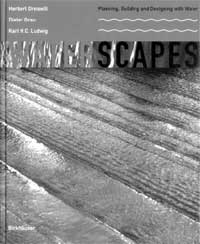Experiencing water
 water has no colour, no taste, no smell and no shape of its own it runs between our fingers, undefined. As long as we have water, often the real value is not realised. While we crave for pure drinking water, we have no qualms in polluting our water sources. It is precisely this paradox that the German authors seek to focus in the book which gently prods the reader to think beyond the utilitarian value of water.
water has no colour, no taste, no smell and no shape of its own it runs between our fingers, undefined. As long as we have water, often the real value is not realised. While we crave for pure drinking water, we have no qualms in polluting our water sources. It is precisely this paradox that the German authors seek to focus in the book which gently prods the reader to think beyond the utilitarian value of water.
The book, a visual delight, has been intelligently put together starting with a quotation by Leonardo da Vinci, "Take thought, when you are speaking of water, that you first recount your experiences, and only afterward your reflections.' One is inclined to sit back with eyes closed, and reflect: what does water mean to me beyond the physical needs that it meets? How often has the sound of water falling soothed frayed nerves, brought about deep introspection and revived a healthy respect for nature? And realisation dawns.
Drawn by the pictures of water in is various forms clouds, glaciers, imprints of water on the sand, waves and many more, the reader is introduced to various examples where water has been linked to urban landscape development and design. Though water management is an important component of city planning, most attempts are made to make it invisible, as in underground sewer and rainwater disposal systems. The projects described in this book attempt to make water visible. All these projects use water more than just as fountains and waterfalls.
What is interesting is that in most of these projects, rainwater has been stored and used not only for the waterscapes but also for reuse in flushing toilets and watering green areas. In Berlin's Potsdame Platz for example, rooftop rainwater is collected in huge underground cisterns, the size of huge storage godowns, which is then fed into the urban surface waterbody after being chemically and biologically purified by passing it through biological purification systems.
In his essay, Wolfgang F Geiger states: "water is neither inexhaustible nor invulnerable. But the intensity with which it is used today tends to ignore these facts, as we increasingly exploit and pollute this gift of nature that is so essential for life. If we do not want to dig for our own water in future, we must think cooperatively, decentralise, and establish autonomous systems for water use at a local level.' Geiger calls for a drastic rethink in urban water management: demands must be commensurate with supply, water problems must be solved specifically and within the immediate vicinity of every town, every district and every neighbourhood. He makes a strong case for decentralised both in terms of responsibility and action and autonomous water supply systems, simply because these cost less, are less prone to technical failure and instil a sense of ownership.
The main objective of the book is to develop a relationship with water and the several projects cited in the book are designed to do precisely that. A water playground in Pforzheim, Germany, attempts to answer several questions that children have on water questions to which adults usually do not have the time or the inclination to answer. In this playground, water is on the move, creates a path for itself, comes to the surface, collects, seeps away, and raises questions. The park has traditional devices for raising water, so that can be raised, played with and experienced.
The people who have made contributions in the book are all
Related Content
- State of the Climate in Asia 2024
- Order of the National Green Tribunal regarding pollution of Godavari river, Telangana, 29/05/2025
- HKS Snow Update 2025
- Drought in the Horn of Africa: regional analysis
- Order of the Supreme Court of India regarding norms and guidelines for the appointment of Chairpersons, Member Secretaries and Members of the SPCBs, 30/01/2023
- Angola country climate and development report
